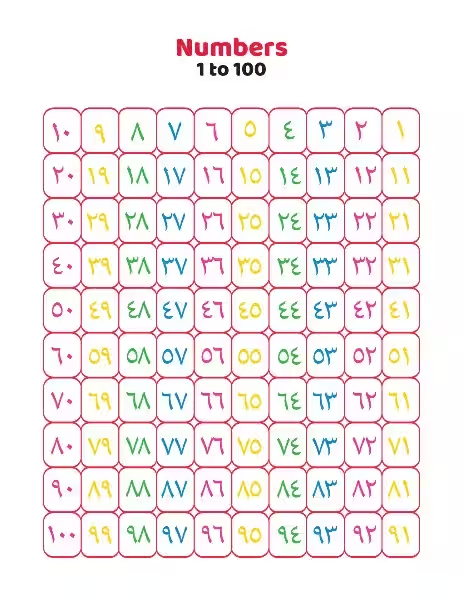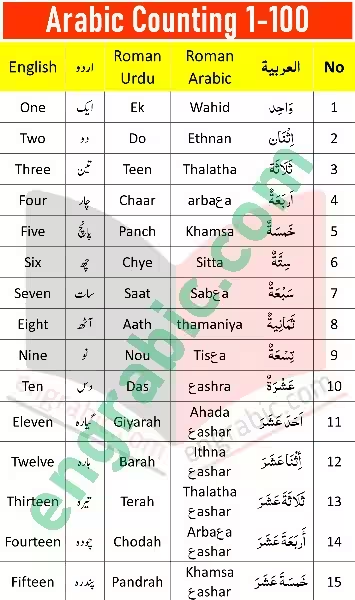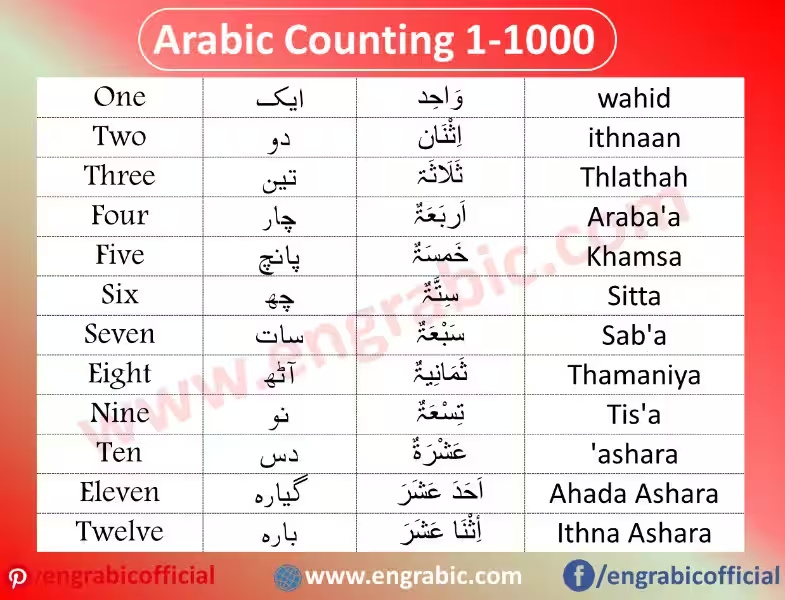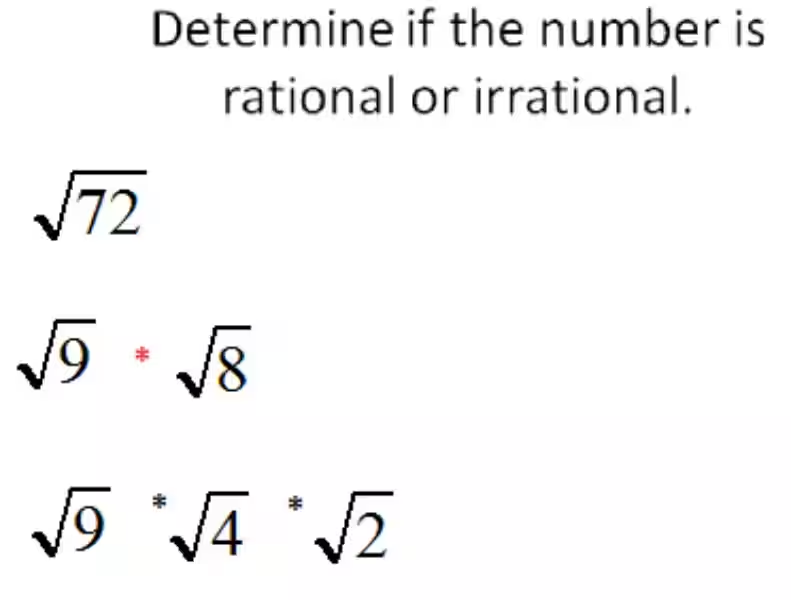
Embark on a journey to mastering Arabic numbers, the foundation of numerical expression in the Arabic language. From counting simple objects to expressing larger quantities, understanding these numbers is essential for navigating everyday interactions and delving deeper into the richness of Arabic culture.
The Basics of Arabic Numbers
The Arabic numeral system, used across all Arabic dialects, follows a logical structure based on simple patterns and phonetic pronunciation. Let’s dive into the core elements that make learning Arabic numbers surprisingly straightforward.
Arabic Number System: A Clear Framework
The Arabic numeral system is a decimal system, meaning it’s based on ten. This shared system, used in various languages and cultures, provides a familiar foundation for learners.
Arabic numbers, unlike the English script, are written from left to right, despite the Arabic language itself being written from right to left. This seemingly counterintuitive aspect adds a unique twist to learning Arabic.
The Importance of Zero
The concept of zero, a revolutionary idea in mathematics, was introduced to the world by an Arab scholar from Iraq named Muhammad ibn Musa al-Khwarizmi. This innovation, crucial to the development of modern mathematics, underscores the significant contributions of Arab mathematicians to the global intellectual landscape.
Understanding the Pattern of Tens
Tens in Arabic are formed by adding the suffix “oon” or “een” to the single number. “Een” is the preferred suffix in spoken Arabic, while “oon” is more common in written Arabic. For example, “ethnein” (two) becomes “eshroon/eshreen” (twenty).
Counting Beyond Tens
Arabic counting past tens follows a different pattern compared to English. Instead of saying “twenty-one,” you say “wahed wa eshreen” (one and twenty). This simple formula, “single number + wa + ten,” is consistent for all numbers between 21 and 99.
Exploring the Numbers 1-100
Let’s explore the numbers from 1 to 100 in detail, highlighting the patterns and variations that make them unique.
Numbers 1-10: The Foundation of Counting
The first ten numbers form the building blocks for all subsequent numbers. Mastering them is crucial for building a solid foundation:
- 1: واحد (pronounced “waa7id”)
- 2: اثنان (pronounced “ithnaan”)
- 3: ثلاثة (pronounced “thalaatha”)
- 4: أربعة (pronounced “arba3a”)
- 5: خمسة (pronounced “khamsa”)
- 6: ستة (pronounced “sita”)
- 7: سبعة (pronounced “sab3a”)
- 8: ثمانية (pronounced “thamaaniya”)
- 9: تسعة (pronounced “tis3a”)
- 10: عشرة (pronounced “3ashara”)
Numbers 11-19: The “Ten” Pattern
This group of numbers follows a consistent pattern: “number + عشر” (meaning “ten”), with a slight modification to the initial number. For instance, “11” is “أحد عشر” (pronounced “a7ada 3ashar”), and “15” is “خمسة عشر” (pronounced “khamsata 3ashar”).
Numbers 20-90: Combining Tens and Singles
This range of numbers uses the formula “number + ون + ten.” “ون” (pronounced “wa”) acts as a conjunction, signifying “and.” For example, “21” is “واحد وعشرون” (pronounced “wa7id wa 3ishroon”) and “30” is “ثلاثون” (pronounced “thalaathoun”).
The Number 100: The First Hundred
One hundred is represented by “مئة” (pronounced “mi’a”). This marks a significant milestone in the Arabic number system, setting the stage for larger quantities.
Beyond the Basics: Plurals and Pronunciation
Arabic numbers, like many other aspects of the language, have singular, double, and plural forms. Double forms often end in “an” or “ein,” with “ein” being more common in spoken Arabic.
Pronunciation is another critical aspect. While this guide provides a basic transliteration, it’s essential to listen to native speakers and practice pronunciation to achieve accurate articulation.
Key Takeaways
Learning Arabic numbers from 1 to 100 is an achievable goal. By understanding the logical structure, patterns, and variations, you can equip yourself with a valuable skill for navigating the Arabic language and culture. Remember to practice pronunciation, engage with native speakers, and enjoy the journey of mastering these essential numbers.
Frequently Asked Questions: Arabic Numbers 1-100
How are Arabic numbers written?
Arabic numbers are written from left to right, the same way they are in English. They use the same Indo-Arabic numerals as English.
What is the Arabic word for “zero”?
The Arabic word for “zero” is “صفر” (pronounced “sifr”).
How are numbers 11-19 formed in Arabic?
Numbers 11-19 are formed by combining the single number (1-9) followed by “عشر” (pronounced “3ashar,” meaning “ten”).
How are numbers 20-90 formed in Arabic?
Numbers 20-90 are formed by combining the single number (1-9) followed by “ون” (pronounced “oon/een,” meaning “and”) and then the appropriate tens digit.
What is the Arabic word for “one hundred”?
The Arabic word for “one hundred” is “مئة” (pronounced “mi’a”).
How are hundreds formed in Arabic?
Hundreds are formed by saying “hundreds (and) singles (and) tens.”
What is the difference between Arabic numbers and Arabic numerals?
Arabic numbers are the Indo-Arabic numerals used in the Arabic language, while Arabic numerals are the system used in Latin languages, including English.
What is nunation and how does it affect pronunciation?
Nunation is a diacritical mark added to the end of certain words, including number words. It affects pronunciation by adding a slight nasal sound.
Are there any pronunciation variations between dialects?
While the written form of Arabic numbers is the same across dialects, pronunciation variations do exist.
- Arabic numbers are written from left to right, even though Arabic script is written from right to left.
- The numbers 1-10 are: واحد (waa7id), اثنان (ithnaan), ثلاثة (thalaatha), أربعة (arba3a), خمسة (khamsa), ستة (sita), سبعة (sab3a), ثمانية (thamaaniya), تسعة (tis3a), عشرة (3ashara).
- Numbers 11-19 follow the pattern “number + عشر (3ashar)”.
- For example, 11 is أحد عشر (a7ada 3ashar) and 15 is خمسة عشر (khamsata 3ashar).
- Numbers 20-90 follow the pattern “number + ون (wan) + tens digit”.
- For example, 21 is واحد وعشرون (wa7id wa 3ishroon) and 30 is ثلاثون (thalaathoun).
- The number 100 is written as مئة (mi’a).
- Numbers past 100 follow the pattern “hundreds (and) singles (and) tens”.
- For example, 123 is مئة وثلاثة وعشرون (mi’a wa thalaatha wa 3ishroon).
- Arabic numbers have singular, dual, and plural forms.
- Dual forms often end in “ان (an)” or “ين (ein)”.
- Plural forms often end in “ون (oon)” or “ين (een)”.
- The “TH” sound in Arabic can be either voiced or unvoiced.
- Pronunciation variations exist between different Arabic dialects.
- The video includes nunation (تنوين) at the end of each number, which is important for proper pronunciation.
- The video provides audio pronunciation of the numbers.
- Use the video and transliteration table to practice pronunciation.
- Break down numbers into smaller parts to make them easier to learn.
- Focus on the patterns and rules of forming numbers.
- Find a native Arabic speaker to help you with pronunciation.
- Use flashcards or other learning tools to memorize the numbers.
- Practice writing the numbers in Arabic script.
- Use Arabic numbers in everyday conversations and activities.
- Don’t be afraid to make mistakes, learning a new language takes time and practice.
- Be patient and persistent, you’ll be surprised how quickly you can learn.
- Enjoy the process of learning Arabic numbers.
- Remember that Arabic numbers are a valuable tool for communication.
- Use them to connect with Arabic speakers and learn more about their culture.
- Be confident in your ability to learn Arabic numbers.
- With dedication and practice, you can master them.
- Take your time and enjoy the journey of learning a new language.
- Good luck!








